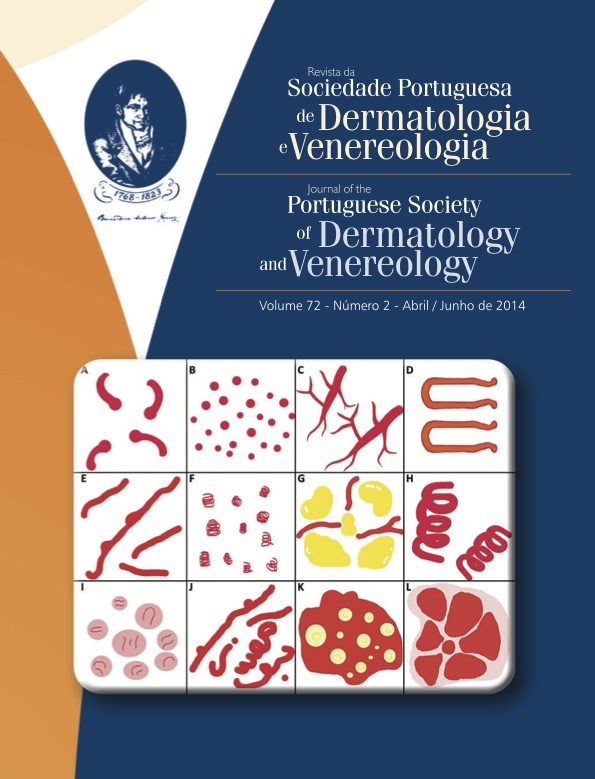PSEUDOXANTHOMA ELASTICUM-LIKE PAPILLARY DERMAL ELASTOLYSIS - A SUBDIAGNOSIS ENTITY
Abstract
Pseudoxanthoma elasticum-like papillary dermal elastolysis (PXE-PDE) is an acquired clinical entity, of unknown etiology, characterized by partial or total absence of elastic fibers in the papillary dermis. We describe the case of a 62-year-old Caucasian woman, Fitzpatrick III skin phototype, with a dermatosis characterized by multiple, asymptomatic, yellowish, monomorphic, rounded papules, with 2-3mm in diameter, located on the posterior and lateral sides of the neck with 2 years of evolution. Histopathological examination revealed a marked reduction of elastic fibres in the papillary dermis confirming PXE-PDE diagnosis. We consider that this entity, exclusively cutaneous, is under-diagnosed because it is an asymptomatic disease, in which histopathological diagnosis is difficult, if it is not clinically considered.
Downloads
References
Lewis KG, Bercovitch L, Dill SW, Robinson-Bostom L. Acquired disorders of elastic tissue: part II. decreased elastic tissue. J Am Acad Dermatol. 2004; 51(2):165-85.
Revelles JM, Machan S, Pielasinski U, Camacho D, Vallés L, Santonja C, et al. Pseudoxanthoma elasticum-like papillary dermal elastolysis: immunohistochemical study using elastic fiber cross-reactivity with an antibody against amyloid p component. Am J Dermatopathol. 2012; 34:637.
Rongioletti F, Rebora A. Pseudoxanthoma elastics-like papillary dermal elastolysis. J Am Acad Dermatol. 1992; 26:648-50.
Rongioletti F, Izakovic J, Romanelli P, Lanuti E, Miteva M. Pseudoxanthoma elasticum-like papillary dermal elastolysis: a large case series with clinicopathological correlation. J Am Acad Dermatol. 2012; 67(1):128-35.
Vargas-Diez E, Penas PF, Fraga J, Aragues M, Garcia-Diez A. Pseudoxanthoma elasticum–like papillary dermal elastolysis. A report of two cases and review of the literature. Acta Derm Venereol. 1997;77:43-5.
Ohnishi Y, Tajima S, Ishibashi A, Inazumi T, Sasaki T, Sakamoto H. Pseudoxanthoma elasticum–like papillary dermal elastolysis: report of four Japanese cases and an immunohistochemical study of elastin and fibrillin-1. Br J Dermatol. 1998; 139:141-4.
Jagdeo J, Ng C, Ronchetti IP, Wilkel C, Bercovitch L, Robinson-Bostom L. Fibroelastolytic papulosis. J Am Acad Dermatol. 2004; 51:958-64.
Alves R, Ferreira L, Vale E, Bordalo O. Pseudoxanthoma elasticum papillary dermal elastolysis: A case report. Dermatol Res Pract. 2010; pii: 352724.
Song YC, Oh BH, Ko JH, Kim JY, Hwang YJ, Lee W, et al. A Case of Fibroelastolytic Papulosis on the Neck of a Young Man. Ann Dermatol. 2011; 23(2):193-7.
All articles in this journal are Open Access under the Creative Commons Attribution-NonCommercial 4.0 International License (CC BY-NC 4.0).








